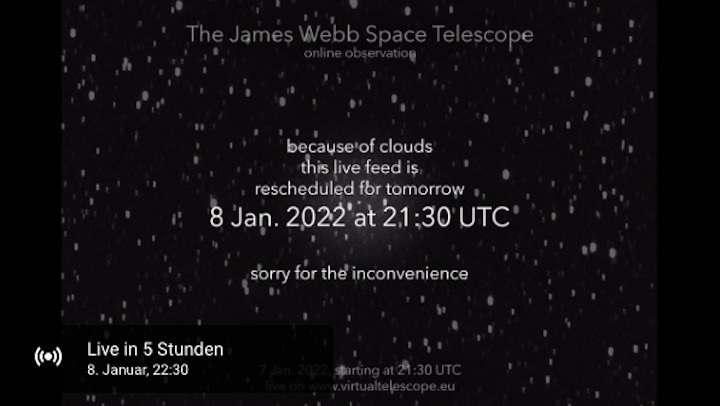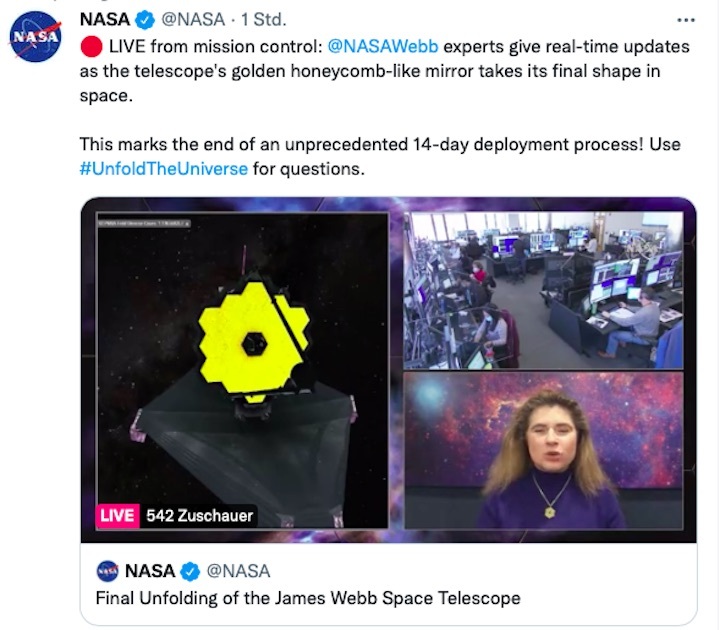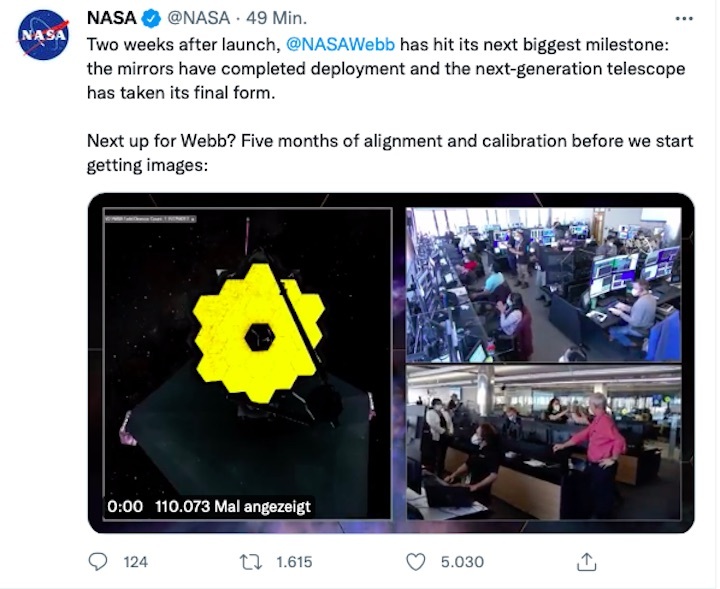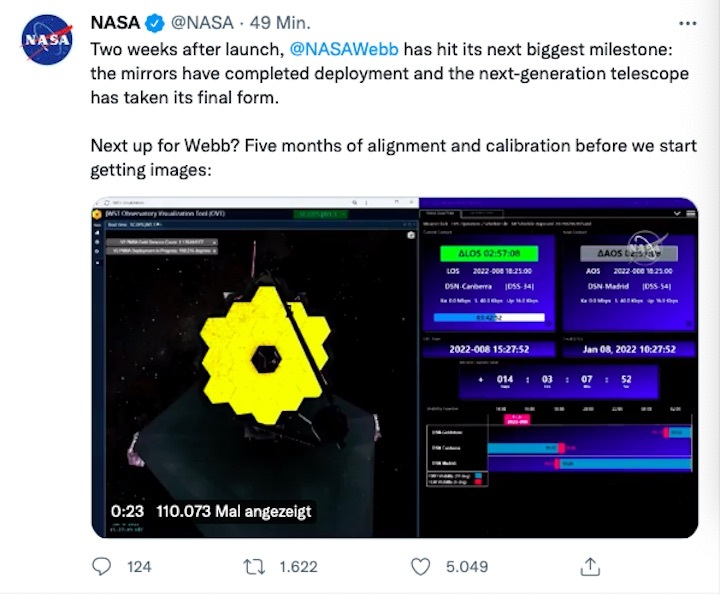2.01.2022
NASA begins unfurling James Webb telescope's critical sunshade
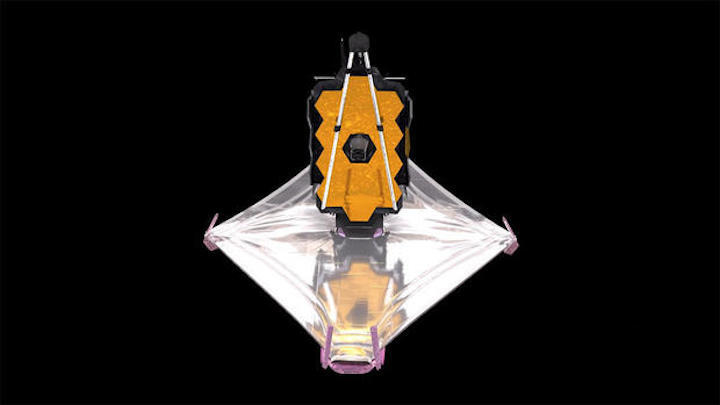
Webb's sunshade has been deployed, but the work will not be complete until its five layers have been pulled tight and separated, providing gaps between each membrane to permit heat to escape to the sides. Motor-driven cables will begin pulling the layers taut on Saturday. NASA
Now a half-million miles and six days outbound from Earth, the James Webb Space Telescope began the most critical phase of its initial activation on Friday, unfolding a fragile five-layer sunshield the size of a tennis court that's essential to its mission.
The two pallets holding the sunshade's hair-thin Kapton layers were unfolded and locked in place Tuesday, one on either side of Webb's 21.3-foot primary mirror. On Thursday, protective covers were commanded to roll off each pallet, exposing the still-folded sunshade membranes to space.
The actual deployment began Friday when the first of two telescoping booms at right angles to the pallets began extending, slowly pulling out one side of the shield, unfolding the membranes as it went. The boom was verified to be fully extended at 4:49 p.m. EST.
"This has been a BIG DAY of @NASAWebb deployments! Closing off the year strong!" NASA science chief Thomas Zurbuchen tweeted.
The deployment of the first boom was held up several hours to give engineers time to make sure the protective covers had, in fact, rolled off to the side of the sunshade pallets as required.
"Switches that should have indicated that the cover rolled up did not trigger when they were supposed to," NASA said in a blog post. "However, secondary and tertiary sources offered confirmation that it had."
"The deployment of the five telescoping segments of the motor-driven mid-boom began around 1:30 p.m., and the arm extended smoothly until it reached full deployment," NASA said.
Engineers then sent commands to deploy the second sunshade boom, which extended smoothly and locked in place at 10:13 p.m., finally giving Webb its iconic kite-like shape.
"Today is an example of why we continue to say that we don't think our deployment schedule might change, but that we expect it to change," said Keith Parrish, the observatory manager at NASA's Goddard Space Flight Center.
Referring to the cautious approach to deploying the first boom, he said "the team did what we had rehearsed for this kind of situation - stop, assess, and move forward methodically with a plan. We still have a long way to go with this whole deployment process."
Simply extending the sunshade is not enough for Webb to meet its science goals. For the shield to work properly, blocking out heat from the sun, its five layers must be pulled taut and separated.
The temperature on the sun-facing side of the fully-deployed shade will reach 230 degrees Fahrenheit. But thanks to the separated layers of the sunshield, the optics on the side facing deep space will be passively cooled to nearly 400 degrees below zero.
That's what's required for Webb to register the faint infrared light from the first stars and galaxies to form in the wake of the Big Bang, one of the telescope's top priorities. And to do that, all five sunshade layers must be pulled taut and fully separated to reach the required low temperature.
Assuming no overnight problems and the full extension of both booms, motor-driven cables will slowly pull the first four layers taut on New Year's Day, separating them from each other in the process. The fifth layer is expected to be tensioned Sunday.
With the sunshade fully extended and taut, engineers will focus on Webb's optical system erecting the telescope's secondary mirror at the tip of an articulating tripod on Tuesday.
Webb's primary mirror, the largest ever launched, is made up of 18 segments, six of which were folded back out of the way to fit inside the nosecone of the telescope's Ariane 5 rocket.
If all goes well, those six segments, three on each side, will be rotated into position Thursday.
After that, engineers will begin a months-long process to precisely align each segment to achieve a razor-sharp focus. After instrument checkouts and calibration, the first science images are expected in about six months.
Quelle: CBS News
+++
Webb telescope unfurls diamond-shaped sunshield
Flying outbound from Earth at a distance of more than 400,000 miles, the James Webb Space Telescope extended two booms Friday and unfurled the mission’s five-layer sunshield to the size of a tennis court, notching a major milestone for the observatory after a nail-biting New Year’s Eve for astronomers and engineers on Earth.
The critical deployments marked some riskiest moments to ready the nearly $10 billion observatory for science operations, following its successful launch Dec. 25 aboard a European Ariane 5 rocket.
NASA confirmed the successful extension of the port-side mid-boom in an update shortly after 7 p.m. EST Friday (0000 GMT Saturday). Nearly four hours later, NASA announced the starboard boom was extended.
Webb’s two sunshield mid-booms are designed to pull out the shade’s five membranes into their distinctive diamond shape.
“The mid-booms are the sunshield’s workhorse and do the heavy lifting to unfold and pull the membranes into that now-iconic shape,” said Keith Parrish, Webb observatory manager at NASA’s Goddard Space Flight Center.
Ground teams started extending the two sunshield booms several hours later than originally scheduled, NASA said in an update Friday evening. The space agency said mission controllers at the Space Telescope Science Institute took extra steps to confirm that a sunshield cover had fully rolled up before proceeding with the first mid-boom deployment.
“Switches that should have indicated that the cover rolled up did not trigger when they were supposed to,” NASA said. “However, secondary and tertiary sources offered confirmation that it had. Temperature data seemed to show that the sunshield cover unrolled to block sunlight from a sensor, and gyroscope sensors indicated motion consistent with the sunshield cover release devices being activated.”
The covers were opened and rolled back to expose the sunshield to space Thursday, but the covers were supposed roll back more in the early phase of mid-boom deployment.
“This final preparation to begin extending the mid-boom was what the team was analyzing before beginning the deployment,” NASA tweeted.
Five telescoping segments of the port, or left-side, mid-boom began extending around 1:30 p.m. EST (1830 GMT) Friday. The motor-driven boom reached full deployment at 4:49 p.m. EST (2149 GMT), NASA said.
The starboard, or right-side boom extension began at 6:31 p.m. EST (2331 GMT) and completed at about 10:13 p.m. EST (0313 GMT).
Both mid-booms are now locked into position o
“The completion of the sunshield cover and mid-boom deployments over the past two days marks a critical milestone for Webb,” NASA said in a written update Friday night.
Webb has 344 devices that must work exactly as intended. Of those, 107 are membrane release devices, non-explosive actuators that pinned the sunshield in place for launch. All 107 successfully released to allow the sunshield to open to its full dimension.
In total, the mission’s deployment sequence relies on 140 release mechanisms, 70 hinge assemblies, eight deployment motors, 400 pulleys, and 90 cables running a quarter-mile in length. There are also an array of bearings, springs, and gears to transform Webb from its launch to operational configuration.
The sunshade stretches 69.5 feet (21.2 meters) long and 46.5 feet (14.2 meters) wide.
Officials have repeatedly said Webb’s deployment schedule could change based on real-time conditions.
“Today is an example of why we continue to say that we don’t think our deployment schedule might change, but that we expect it to change,” Parrish said. “The team did what we had rehearsed for this kind of situation – stop, assess, and move forward methodically with a plan. We still have a long way to go with this whole deployment process.”
Made of five fragile kapton membranes, each as thin as a human hair, the sunshield will keep Webb’s mirrors, instruments, and detectors in constant shadow, allowing their operating temperature to plummet to near minus 400 degrees Fahrenheit. Such cold conditions are required to allow Webb to see the faint infrared light from the first galaxies in the universe more than 13.5 billion light years away.
Before Webb’s launch, most NASA managers and astronomers waiting to use the Webb telescope, the product of nearly three decades of development, gave the same answer about the most stressful moment of the mission: Sunshield deployment.
“The sunshield is one of these things that is almost inherently indeterministic,” said Mike Menzel, Webb’s mission systems engineer at NASA’s Goddard Space Flight Center in Maryland. “NASA is used to deploying rigid beams on hinges, because they’re deterministic, you can determine how they move.”
“Given that there are 40 different major deployments, and hundreds of pulleys and wires, the whole thing makes me nervous and will until its fully deployed,” said John Grunsfeld, an astrophysicist, former astronaut, and head of NASA’s science mission directorate from 2012 until 2016, a key period in Webb’s development.
But it’s the sunshield that got the biggest share of Menzel’s attention during the design and testing of Webb.
Menzel compared predicting the behavior of the sunshield layers to guessing what a string will do when you push it on a table top.
“So it is with the membranes of the sunshield,” he said. “So we can’t really predict their shape, but we can constrain it. “We can try to prevent it from going in places that we don’t want it to go, places where it could snag or tear, or maybe impede the deployment of other members.”
Each layer of the sunshield is slightly different in size and shape, created using thermally bonded sections of kapton with around 10,000 seams, according to Krystal Puga, Webb’s lead spacecraft systems engineer at Northrop Grumman.
There are reinforcement strips, or rip stops, to contain any tears or holes, and metallic ribbons giving the kapton some structural support.
The sunshield membranes are coated with aluminum, and two of the outermost layers are treated with silicon, giving the skin-like material a purple hue.
With the sunshield in its diamond shape, Webb controllers will send commands for the observatory to tension each of the five layers over two days — currently planned on Saturday and Sunday.
“Once we get the sunshield out, that’s great, but then we have to sort of tighten it up,” Parrish said in an interview before launch. “All five layers have different points around them where they’re connected up, and then we’ll pull on cables in each one of those corners to actually tighten up the sunshield.”
“The very last step is super important,” Puga said. “We need to tension all of the membranes using a series of pulleys and cables to create the separation between each of the five layers.”
The tensioning will separate each of the five ultra-thin kapton membranes, spacing them a few inches at the center and a few feet at the outermost edges. The tapered spacing helps allow heat from the sun to reflect between the layers, and eventually radiate back into space.
Tightening the sunshield will begin with the largest and flattest membrane closest to the sun, which will reach the hottest temperatures during the mission. One-by-one, each of the other four layers will be tensioned, ending with the smallest and coldest layer closest to Webb’s mirror.
“Tensioning the layers involves sending commands to activate several motors to reel in a total of 90 cables through numerous pulleys and cable management devices. Sunshield tensioning will take at least two days but may take longer, due to the complexity of the process and the flexibility built into the timeline,” NASA said Friday night.
Webb’s instruments and telescope need to be super-cold to make them sensitive to infrared light. And astronomers want to observe the cosmos in infrared wavelengths because it allows them to see the oldest galaxies, whose light waves have been stretched by the expansion of the universe.
Infrared astronomy also reveals star-forming regions obscured by clouds of gas and dust opaque to telescopes that see in visible wavelengths, the kind of light detectable by the human eye.
McCaughrean, an astronomer working on Webb since the 1990s, tweeted that infrared astronomy with a warm telescope “is like trying to observe in the visible in broad daylight with a telescope made of light bulbs. Possible, but you won’t see faint things very well.”
Once the sunshield is deployed and tensioned, ground teams will turn their attention to unfolding Webb’s huge mirror to its full size and shape. Those events are scheduled for next week.
Webb is cruising toward its operations post in a halo-like orbit around the L2 Lagrange point, a gravitational balance point nearly a million miles (1.5 million kilometers) from Earth.
Quelle: SN
----
Update: 5.01.2022
.
NASA's new space telescope 'hunky-dory' after problems fixed
NASA's new space telescope is doing well more than a week after liftoff, following a pair of problems overcome by ground controllers
CAPE CANAVERAL, Fla. -- NASA’s new space telescope is on the verge of completing the riskiest part of its mission — unfolding and tightening a huge sunshade — after ground controllers fixed a pair of problems, officials said Monday.
The tennis court-size sunshield on the James Webb Space Telescope is now fully open and in the process of being stretched tight. The operation should be complete by Wednesday.
The $10 billion telescope — the largest and most powerful astronomical observatory ever launched — rocketed away Christmas Day from French Guiana. Its sunshield and primary mirror had to be folded to fit into the European Ariane rocket.
The sunshield is vital for keeping Webb's infrared-sensing instruments at subzero temperatures, as they scan the universe for the first stars and galaxies, and examine the atmospheres of alien worlds for possible signs of life.
Getting the sunshield extended last Friday "was really a huge achievement for us," said project manager Bill Ochs. All 107 release pins opened properly.
But there have been a few obstacles.
Flight controllers in Maryland had to reset Webb’s solar panel to draw more power. The observatory — considered the successor to the aging Hubble Space Telescope — was never in any danger, with a constant power flow, said Amy Lo, a lead engineer for the telescope's prime contractor, Northrop Grumman.
They also repointed the telescope to limit sunlight on six overheating motors. The motors cooled enough to begin securing the sunshield, a three-day process that can be halted if the problem crops up again, officials said.
“Everything is hunky-dory and doing well now,” Lo said.
Ochs expects the tightening of the sunshield to be drama-free.
“The best thing for operations is boring, and that’s what we anticipate over the next three days, is to be boring," he told reporters in a teleconference.
If that holds true, the telescope's gold-plated mirror — more than 21 feet (6.5 meters) across — could unfold as soon as this weekend.
Webb should reach its destination 1 million miles (1.6 million kilometers) away by the end of January. As of Monday, the telescope was more than halfway there. The infrared telescope should begin observing the cosmos by the end of June, ultimately unveiling the first stars and galaxies formed in the universe 13.7 billion years ago. That's a mere 100 million years after the universe-creating Big Bang.
Launched in 1990, Hubble, which sees primarily visible light, has peered as far back as 13.4 billion years ago. Astronomers hope to close the gap with Webb, which is 100 times more powerful.
In another bit of good news Monday, officials said they expect Webb to last well beyond the originally anticipated 10 years based on its fuel efficiency.
Quelle: abcNews
+++
James Webb Space Telescope: Everything is 'hunky dory'
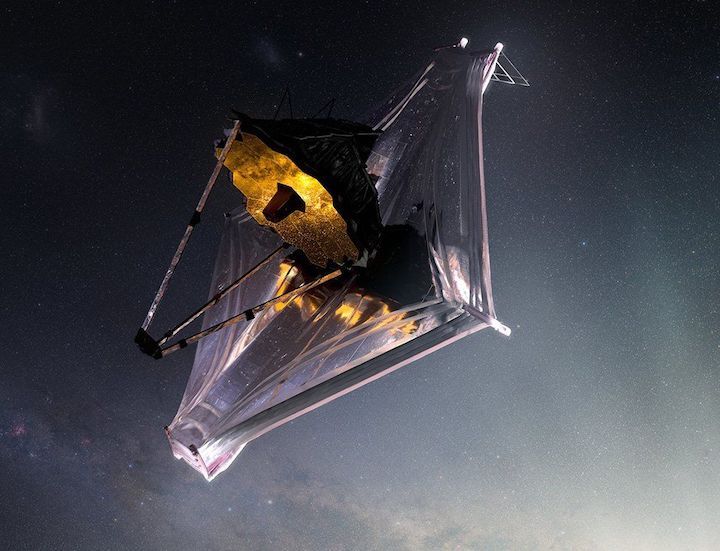
So far, so good. The US space agency says the post-launch set-up of the new James Webb telescope has gone very well.
"As smoothly as we could have hoped for."
Engineering teams are in the middle of unpacking the observatory from its folded launch configuration to the layout needed for operations.
This involves the deployment of several structures, the most critical of which are Webb's mirrors and sun shield.
Monday saw the start of what is probably the most complex set of activities - the separation and tensioning of the five individual layers that make up the shield.
Each membrane in the shield is as thin as a human hair and must be gently pulled tight to form a rigid, kite-like barrier the size of a tennis court.
The task was practised multiple times on the ground with full-scale and sub-scale models, which Nasa's Bill Ochs says gives him confidence that all will go well.
"I don't expect any drama," the project manager told reporters on Monday. "The best thing for operations is 'boring'. And that's what we anticipate over the next three days - to be boring."
Engineers refer to "single point failures" to describe the actions, which, if they don't occur on cue and in the right order, are likely to scupper the whole undertaking. Webb must get past 344 of these hurdles to achieve its operational layout.
If the sun shield opens perfectly - which may even be accomplished as early as Tuesday - then 75% of those failure modes will have been overcome.
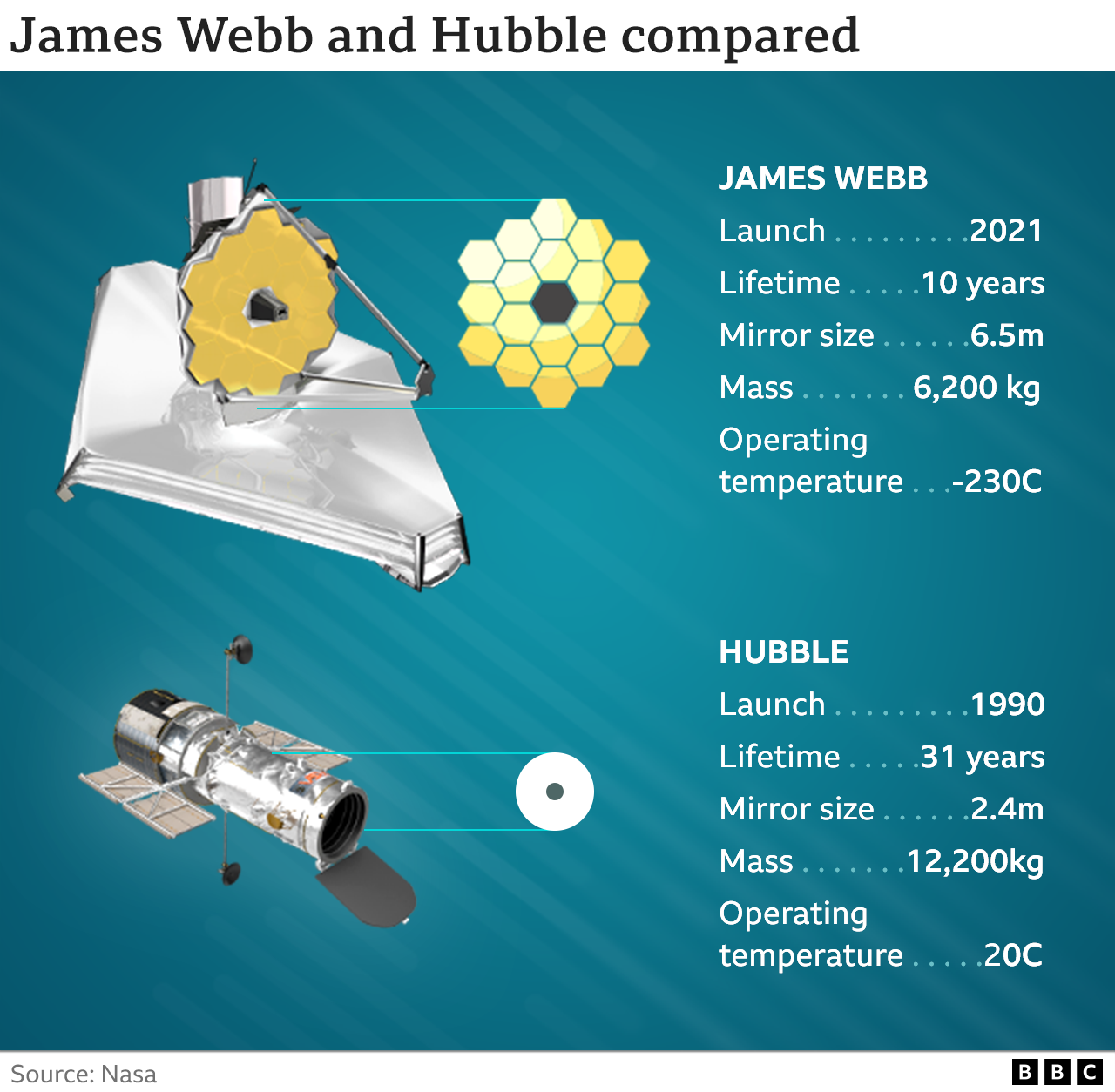
Mission controllers at the Space Telescope Science Institute (STScI) in Baltimore, Maryland, would then move on to deploying Webb's mirrors
The telescope has a secondary reflector that must be extended on long booms in front of the primary mirror. Friday is the current target for this.
The main mirror has "wings" that were tucked back for launch but which must now be rotated through 90 degrees to make a full, 6.5m-wide surface. Again, assuming things continue to run like clockwork, this should happen over the weekend.
The unfolding schedule has slipped somewhat from the prelaunch plan, but not because of any particular problems, said Bill Ochs. The engineering teams were simply taking a steady, methodical approach to their work, he stressed.
"We are still in the 'getting to know you' phase with the telescope. All satellites will be a little bit different on orbit than they are on the ground," he explained.
"It takes time to get to understand their characteristics, and that's a lot of what we've been doing over the last week, as well as still making excellent progress on the commissioning timeline."
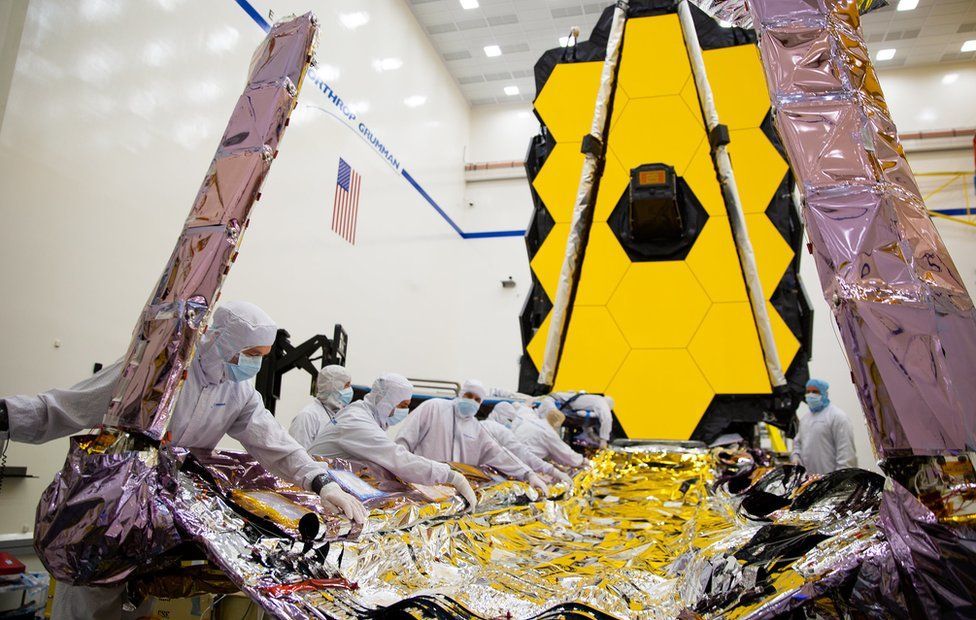 IMAGE SOURCE, NASA
IMAGE SOURCE, NASAOne of these learning moments involved the teams getting a better handle on how to manage the temperatures inside the motors that are used to drive the sun shield's deployment. A second involved the fine-tuning of Webb's solar array so that it can output the necessary power for the separation and tensioning of the membranes - as well as the mirror unpacking.
"Everything is hunky dory and doing well," said Amy Lo from Northrop Grumman, the American aerospace company that assembled Webb.
"The rebalancing of the array gives us quite a lot of margin for the expected increase in power that we will be needing as we proceed on commissioning."
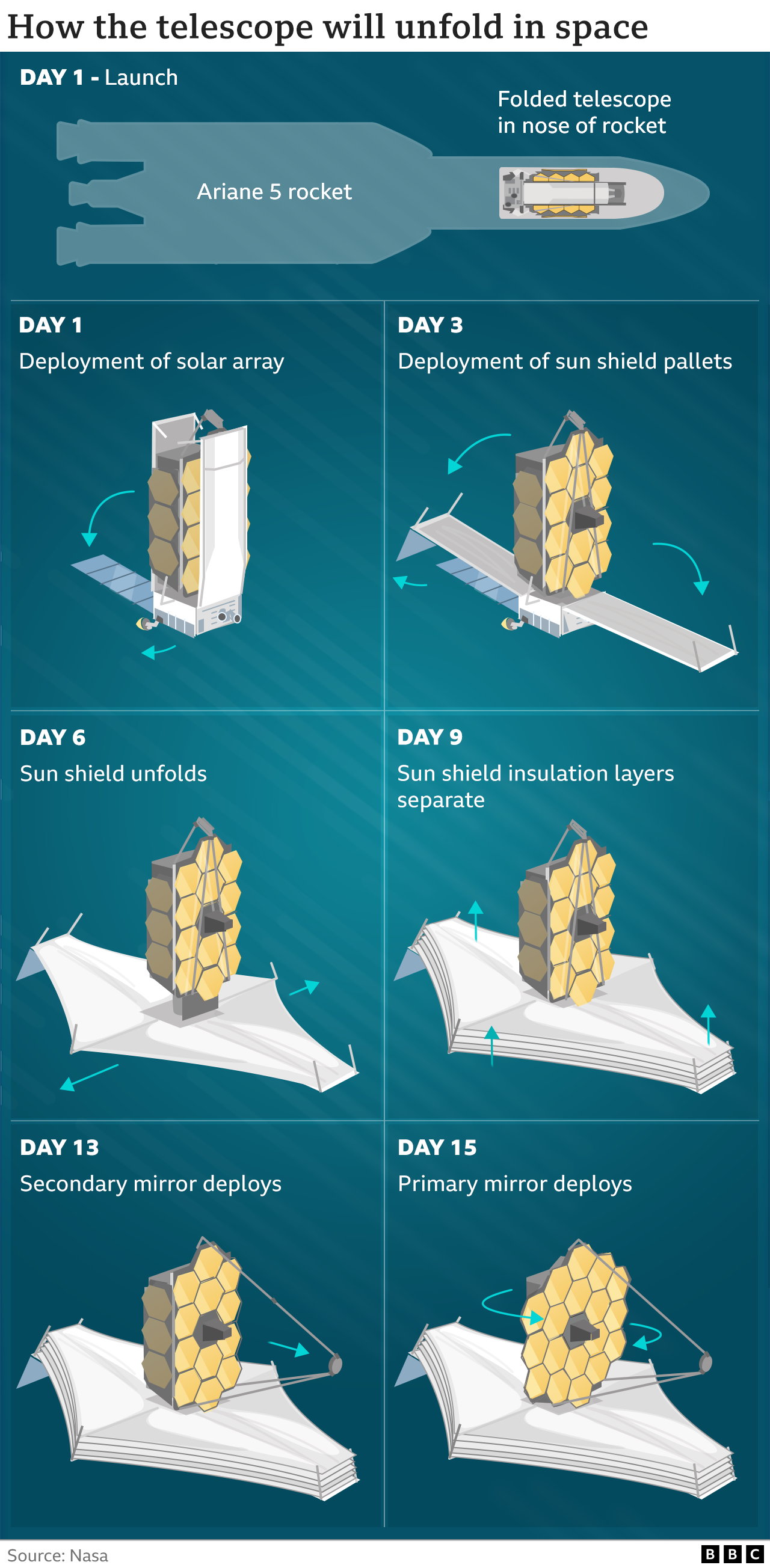

James Webb was launched on 25 December on an Ariane rocket from French Guiana.
The telescope is regarded as the successor to the Hubble space observatory which is now 31 years old and nearing the end of its operational life.
Webb will do similar science to Hubble but with the next-generation technologies that allow it to see deeper into cosmos and, therefore, further back in time. Indeed, scientists expect the new facility to detect the very first stars to ignite after the Big Bang more than 13.5 billion years ago.
But, unlike Hubble, Webb cannot be serviced by astronauts and so cannot achieve the same longevity as its predecessor.
That said, officials now think Webb will work for "a lot more" than the 10 years originally envisaged because its Ariane rocket was so accurate.
The European booster put Webb on a near-perfect trajectory with just the right amount of velocity. This performance meant the telescope didn't have to use so much of its own fuel when making later course refinements. The saved fuel will now be available for the everyday manoeuvres required to keep Webb sitting tidily at its observing position 1.5 million km from Earth.
James Webb is a joint venture between the American, European and Canadian space agencies.
Quelle: BBC
----
Update: 6.01.2022
.
Sunshield Successfully Deploys on NASA’s Next Flagship Telescope

The James Webb Space Telescope team has fully deployed the spacecraft’s 70-foot sunshield, a key milestone in preparing it for science operations.
The sunshield – about the size of a tennis court at full size – was folded to fit inside the payload area of an Arianespace Ariane 5 rocket’s nose cone prior to launch. The Webb team began remotely deploying the sunshield Dec. 28, 2021, three days after launch.
NASA will hold a media teleconference at 12:45 p.m. EST today, Tuesday, Jan. 4, to discuss the completion of this critical step. To participate by telephone, media must RSVP to Laura Betz at: laura.e.betz@nasa.gov. Audio of the teleconference will also stream on the agency’s website.
“This is the first time anyone has ever attempted to put a telescope this large into space,” said Thomas Zurbuchen, associate administrator for NASA’s Science Mission Directorate at the agency’s headquarters in Washington. “Webb required not only careful assembly but also careful deployments. The success of its most challenging deployment – the sunshield – is an incredible testament to the human ingenuity and engineering skill that will enable Webb to accomplish its science goals.”
The five-layered sunshield will protect the telescope from the light and heat of the Sun, Earth, and Moon. Each plastic sheet is about as thin as a human hair and coated with reflective metal, providing protection on the order of more than SPF 1 million. Together, the five layers reduce exposure from the Sun from over 200 kilowatts of solar energy to a fraction of a watt.
This protection is crucial to keep Webb’s scientific instruments at temperatures of 40 kelvins, or under minus 380 degrees Fahrenheit – cold enough to see the faint infrared light that Webb seeks to observe.
“Unfolding Webb’s sunshield in space is an incredible milestone, crucial to the success of the mission,” said Gregory L. Robinson, Webb’s program director at NASA Headquarters. “Thousands of parts had to work with precision for this marvel of engineering to fully unfurl. The team has accomplished an audacious feat with the complexity of this deployment – one of the boldest undertakings yet for Webb.”
The unfolding occurred in the following order, over the course of eight days:
- Two pallet structures – forward and aft – unfolded to bring the observatory to its full 70-foot length
- The Deployable Tower Assembly deployed to separate the telescope and instruments from the sunshield and the main body of the spacecraft, allowing room for the sunshield to fully deploy
- The aft momentum flap and membrane covers were released and deployed
- The mid-booms deployed, expanding perpendicular to the pallet structures and allowing the sunshield to extend to its full width of 47 feet
- Finally, at approximately 11:59 a.m. EST Tuesday, the sunshield was fully tensioned and secured into position, marking the completion of the sunshield deployment
The unfolding and tensioning of the sunshield involved 139 of Webb’s 178 release mechanisms, 70 hinge assemblies, eight deployment motors, roughly 400 pulleys, and 90 individual cables totaling roughly one quarter of a mile in length. The team also paused deployment operations for a day to work on optimizing Webb’s power systems and tensioning motors, to ensure Webb was in prime condition before beginning the major work of sunshield tensioning.
“The sunshield is remarkable as it will protect the telescope on this historic mission,” said Jim Flynn, sunshield manager at Northrop Grumman, NASA’s primary contractor for Webb. “This milestone represents the pioneering spirit of thousands of engineers, scientists, and technicians who spent significant portions of their careers developing, designing, manufacturing, and testing this first-of-its-kind space technology.”
The world’s largest and most complex space science observatory has another 5 1/2 months of setup still to come, including deployment of the secondary mirror and primary mirror wings, alignment of the telescope optics, and calibration of the science instruments. After that, Webb will deliver its first images.
The telescope’s revolutionary technology will explore every phase of cosmic history – from within our solar system to the most distant observable galaxies in the early universe, to everything in between. Webb will reveal new and unexpected discoveries and help humanity understand the origins of the universe and our place in it.
The James Webb Space Telescope is an international partnership with the ESA (European Space Agency) and the Canadian Space Agency. NASA Headquarters oversees the mission. NASA’s Goddard Space Flight Center in Greenbelt, Maryland, manages Webb for the agency and oversees work on the mission performed by the Space Telescope Science Institute, Northrop Grumman, and other mission partners. In addition to Goddard, several NASA centers contributed to the project, including the agency’s Johnson Space Center in Houston, Jet Propulsion Laboratory in Southern California, Marshall Space Flight Center in Huntsville, Alabama, Ames Research Center in California’s Silicon Valley, and others.
Quelle: NASA
----
Update: 8.01.2022
.
NASA to Host Coverage, Briefing for Webb Telescope’s Final Unfolding
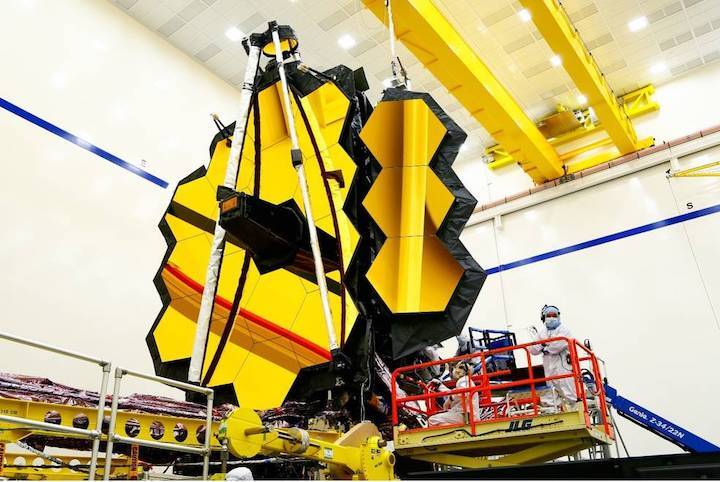
NASA will provide live coverage and host a media briefing Saturday, Jan. 8, for the conclusion of the James Webb Space Telescope’s major spacecraft deployments.
Beginning no earlier than 9 a.m. EST, NASA will air live coverage of the final hours of Webb’s major deployments. After the live broadcast concludes, at approximately 1:30 p.m., NASA will hold a media briefing. Both the broadcast and media briefing will air live on NASA TV, the NASA app, and the agency’s website.
As the final step in the observatory’s major deployments, the Webb team plans to unfold the second of two primary mirror wings. When this step is complete, Webb will have finished its unprecedented process of unfolding in space to prepare for science operations.
To join the briefing, media must RSVP no later than two hours before the start of the call to Laura Betz at: laura.e.betz@nasa.gov. NASA’s media accreditation policy for virtual activities is available online.
Webb, an international partnership with the ESA (European Space Agency) and the Canadian Space Agency, launched Dec. 25 from Europe’s Spaceport in Kourou, French Guiana. Webb is now in the process of unfolding into its final configuration in space, a human-controlled process that provides the team with the flexibility to pause and adjust as needed.
As a result of this process, the timing of these milestones may change. NASA provides regular updates on the Webb telescope blog. The public can also follow Webb’s deployments online via a “Where is Webb?” interactive tracker and a Deployments Explorer webpage.
Once fully operational, Webb will explore every phase of cosmic history – from within the solar system to the most distant observable galaxies in the early universe, and everything in between. Webb will reveal new and unexpected discoveries and help humanity understand the origins of the universe and our place in it.
Quelle: NASA
+++
James Webb Space Telescope has unfolded 1st wing of massive golden mirror
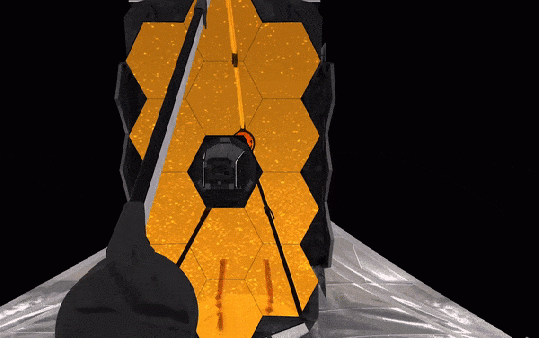
An animation shows the deployment of the port side of the primary mirror of the James Webb Space Telescope. (Image credit: NASA)
The iconic golden mirror of NASA's massive new observatory is taking shape.
The James Webb Space Telescope unfolded the panel that carries the three leftmost segments of its hexagonal gold-coated primary mirror on Friday (Jan. 7). Nearly two weeks after the observatory's launch, the successful maneuver brings the telescope close to its final form.
"Webb's iconic primary mirror is taking its final shape. Today, the first of two primary mirror wings, or side panels, was deployed and latched successfully," NASA officials wrote in a statement.
Team members will repeat the process on the right, or starboard, side of the observatory on Saturday (Jan. 8). NASA has said it will broadcast the procedure live from mission control beginning around 9 a.m. EST (1400 GMT).
Completing the full hexagon with the two panel deployments will mark the end of the major unfolding steps for the observatory after its launch on Dec. 25. To mark the milestone, NASA has also said it will hold a news conference on Saturday around 1:30 p.m. EST (1830 GMT).
Fully deployed, the primary mirror will stretch 21 feet (6.5 meters) across. In the coming days, the JWST team will tweak the arrangement of the 18 individual mirror segments, each of which is controlled by seven actuators, according to a deployment timeline provided by NASA. The team will continue adjusting the mirror segments throughout the five-month commissioning process, which will turn Webb's view from a patchwork of 18 frames into one smooth image.
The observatory also has about two more weeks of travel before it reaches its station orbiting the Earth-sun Lagrange point 2, or L2, which is located nearly 1 million miles (about 1.5 million kilometers) away from Earth on the side opposite the sun. JWST will execute a third and final course correction burn to reach orbit; the first two burns occurred shortly after launch.
Webb is expected to begin science observations this summer.
Quelle: SC
+++

